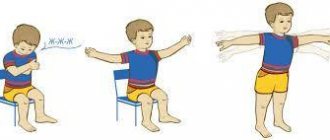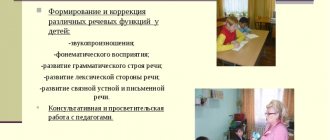Corrective work of a teacher with children with speech disorders
Elena Guryeva
Corrective work of a teacher with children with speech disorders
In order to talk about correctional speech direction of work, we need to analyze the basic concepts of this topic.
Over the past two decades, the statistics of identified speech abnormalities has increased tenfold. The largest group - up to 60% of all preschool children - today are children with speech development disorders.
If a child is silent, does not speak independently, or the formation of speech does not correspond to age, he uses a primitive set of words with “porridge” in his mouth or speaks an incomprehensible “bird” language, he is a non-speaking, speechless child who needs correctional help.
General speech underdevelopment is a variety of complex speech disorders in which the formation of all components of the speech system related to its sound and semantic aspects is impaired in children.
Correctional work is a system of special pedagogical techniques and measures aimed not only at correcting individual violations, but at shaping the personality as a whole. Correctional work is a supplement to the main educational process and contributes to more effective development of the child, the discovery and realization of his abilities in various areas.
The term has been used since the end of the 19th century, initially only in relation to mentally retarded children; in modern domestic defectology it is interpreted more broadly: it is a single educational process, which includes training, education and development.
The goal of correctional and developmental work is to promote the development of the child, create conditions for the realization of his internal potential, help in overcoming and compensating for deviations that interfere with his development. Achieving this goal is possible only if correctional and developmental work is built taking into account the age characteristics of children and characteristics associated with the nature of the ontogenetic disorder.
Features of correctional and developmental work:
• creating a positive psychological atmosphere;
All of us, parents, have all taken our children to kindergartens and schools, so we understand that as soon as you cross the threshold of an educational institution, you can feel an atmosphere of relaxedness or closedness, calm concentration or anxious tension, sincere fun or gloomy alertness.
To create conditions for a psychologically comfortable stay of a child in kindergarten, it is necessary:
- accept each child as he is, regardless of his personal qualities;
- educators, when communicating with a child, must use a whole range of communication skills and abilities necessary for pedagogical communication; The teacher must try to see the individuality of each child, understand his emotional state, respond to experiences, take the position of the child, and inspire confidence in himself.
— the communication style of kindergarten employees must be based on cooperation and respect.
• tasks are performed in a playful way;
The leading and main activity of a preschooler is play. This is a unique way of processing received impressions. It is in play that a child’s thinking, emotions, communication, imagination, consciousness and speech develop most intensively. It is in play that children learn to control and evaluate themselves, to understand what they are doing.
• tracking of the child’s development results is carried out at each lesson;
This way we can assess the degree of progress of the preschooler in the educational program and, if necessary, revise the educational route.
• to achieve a developmental effect, repeated repetition and completion of tasks is necessary.
Lack of concentration and rapid dispersion of attention, excessive mobility and emotional problems lead to the fact that it is difficult or impossible for them to immediately complete tasks on their own and achieve the desired results. Therefore, the educational material is subject to repeated reinforcement.
General principles and rules of correctional work:
1. Individual approach to each student. It is known that every child is unique. The individual characteristics of a child influence his acquisition of skills and abilities and his attitude towards others. When organizing the educational process, one should proceed from the child’s capabilities - the task should be in the zone of moderate difficulty, but be accessible.
2. Preventing the onset of fatigue. Using alternation of mental and practical activities, presenting material in small doses, using interesting and colorful didactic material and visual aids.
3. The use of methods that activate the cognitive and speech activity of children. It is important to use training, without coercion, based on interest, success, trust, through completing tasks that are accessible in pace and nature.
4. Demonstration of pedagogical tact. Constant encouragement for the slightest success, timely and tactical assistance to each child, developing in him faith in his own strengths and capabilities.
Among the skills and abilities that need to be developed in preschoolers, the skills of coherent speech deserve special attention, since the degree of their formation determines the further development of the child and his acquisition of educational knowledge in the school education system.
The level of speech that these children have - vocalizations, onomatopoeia and sound complexes, emotional exclamations, even individual vaguely pronounced everyday words - allows us to say that the child does not have coherent speech skills.
For various reasons, there are more and more children with delayed speech development. Most often, delayed speech development is not an independent disease, but a consequence of abnormalities in the development of the brain and central nervous system.
More often than not, impaired sound pronunciation, which is most noticeable during the first communication with a child, is not the only manifestation of abnormal speech development. Other speech and non-speech functions are also impaired.
This includes features of the development of visual-motor coordination, spatial concepts, fine motor skills, sense of rhythm, perception, attention, memory, and thinking. In addition, these children have no need for communication and have not developed pre-verbal means of communication; auditory attention and perception, phonemic hearing and articulatory apparatus, which ensure the formation of the sound side of speech, are not formed.
In the development of speech, the primary role is played by the processes of non-speech, direct cognition, carried out through the senses: perception, attention, imagination, memory and thinking. And precisely, the immaturity and underdevelopment of each of these processes can lead to a delay in the formation of speech as a means of communication.
It is important to understand that the child’s brain is quite plastic, neuropsychic functions are in the process of continuous development and maturation, therefore correctional work with children suffering from general speech underdevelopment is ultimately aimed at stimulating brain function and developing mental functions. Completing tasks forces the child to analyze, compare and generalize. The child develops the ability to think. Regardless of which component of speech function (speech or non-speech) a specific task is aimed at developing, it is necessary that it be selected taking into account the individual intellectual and speech capabilities of the child. A task that is too complex will cause a rapid loss of interest, while a task that is too easy will not allow the child to expand his cognitive abilities and compensate for the lag in the development of certain functions.
At the first stage, it is necessary to connect the word with the image of each object, its action, quality, and property. This is an examination of the objects being studied, carried out on a sensory basis; handling objects, pictures. For example, if a child is given instructions: take a cube, but the child does not know what it is; put a red cube on a green one, and he does not understand the meaning of the words red, green, but if he does not know the meaning of the preposition na, his actions will be unfocused. In all these cases, the instruction actually remains unfulfilled.
In order for a word to evoke a certain image in memory, the child must already perceive this object quite clearly. For example, when hearing the word cup, a child should remember exactly a cup, and not a glass, as is often the case with children of the studied category. The same stage must be passed when mastering the designations of actions - verbs (put, pour, designation of qualities (colors, shapes, definition of quantities) and properties - adjectives (glass, hot).
Thus, the absence or underdevelopment of speech is a systemic disorder that has a certain structure: a connection between speech and non-speech symptoms, and includes the following components:
Development:
1. Motor skills (general, manual, finger, facial, articulatory);
2. Non-speech mental functions (NSF)
- auditory and visual perception, attention, memory;
— optical-spatial relations and representations (the child’s orientation relative to himself in space, in the diagram of his body);
3. Speech functions:
- phonetic (sound pronunciation);
- phonemic (the ability to distinguish phonemes (sounds) of the native language);
- lexical structure of speech (vocabulary);
- grammatical structure of speech (inflection and word formation);
- semantic (notional).
Consequently, the entire work of a teacher consists of performing tasks aimed at correcting all these components of the structure of a speech defect.
Correctional speech tasks:
1. Constant improvement of articulatory, fine and gross motor skills.
2. Development of correct speech breathing.
3. Consolidating the pronunciation of sounds given by the speech therapist.
4. Development of phonemic representations.
5. Purposeful activation of practiced vocabulary.
6. Correct use of formed grammatical categories.
7. Development of attention, memory, logical thinking as one of the functions of speech in games and exercises.
8. Formation of coherent speech.
These correctional speech problems can be solved:
• during specially organized training of children in the form of classes;
• joint activities between adults and children;
• free independent activity of children.
An important component of the environment is the correct speech of adults. “Before embarking on the responsible task of developing the speech of your pupils, ... you should take care of the development of your own speech,” reminds educators Elizaveta Ivanovna Tikheyeva (Russian and Soviet teacher, the largest specialist in preschool education of children). It should be clear, extremely intelligible, well intonated, and expressive. When addressing children, complex inverted constructions, repetitions, and introductory words that complicate the understanding of speech should be avoided.
Methodological requirements for adult speech
• speech must be absolutely correct, literary;
• speech must always be impeccably polite in form and tone;
• the structure of speech should be coordinated with the age of the children: the younger the child, the simpler the syntactic structure of the speech addressed to him should be;
• the content of adults' speech must strictly correspond to the development, stock of ideas and interests of children, and be based on their experience;
• adult speech must meet such criteria as accuracy, clarity, simplicity, emotional expressiveness, imagery, measured tempo and sufficient (but not excessive) volume.
Certain requirements must be observed regarding the correction of errors in children's speech: they must be made in a tactful, gentle manner and only with confidence that the correction will reach the children's consciousness. “Under no circumstances should corrections be made hastily, in passing, in the midst of work or play, when children are passionate about something,” warns E. I. Tikheyeva. “At best, such amendments are wasted; at worst, they irritate children.”
The process of teaching children with general speech underdevelopment has a number of features and depends on many factors, one of them is knowledge about the severity and structure of the speech defect. A description of the causes (etiology, structure and manifestations of general underdevelopment of speech belongs to the field of special knowledge, but this knowledge is important for the teacher, without it full-fledged correctional and educational work is impossible. Without sufficient information about the speech and intellectual characteristics of children with speech disorders, it is difficult to establish trusting relationship with an individual child, taking into account his emotional state, separating elements of pedagogical neglect from manifestations of neurological symptoms, correctly organizing the educational process and creating a subject-development environment.
The job description of a correctional group teacher must specify all aspects of working with children with speech pathology.
The teacher should know:
— psychological and pedagogical characteristics of children with special needs development
— educational program for the upbringing and training of preschool educational institutions and an adapted correctional program;
To perform the functions assigned to him, the teacher is obliged to:
- carry out correctional work on the instructions of the teacher - speech therapist (speech pathologist);
— organize work to ensure a developmental environment in the group, participate in its transformation in accordance with the age needs of children, their level of development and the requirements of the programs being implemented;
One of the main conditions for the quality of speech correction intervention is the teacher’s sincere interest in its results, the desire to help the child and constant readiness to provide him with the necessary help and support in cases of difficulties. Children, for the most part, have a hyper-vulnerable nervous system and are sensitive not only to the content, but also to the form and intonation of speech addressed to them. Therefore, the child’s attitude to the measures of the proposed pedagogical assistance and the motivation to accept it depend on the level of professional skill, general and speech culture, tact, and patience of the teacher, but at the same time on his perseverance and consistency in work.
The earlier correctional and educational work is started, the more successfully the defect is overcome.
Where to start planning educational work in groups for children with special needs? First of all, it is necessary to adapt a child with speech pathology to new, unusual living conditions for him, to new premises of group rooms, bedrooms, and so on, i.e., create the psychological comfort that we talked about earlier.
The organization of a subject-spatial developmental environment is very important in the formation of higher mental functions in a child with problems in speech development. When organizing a subject-developmental environment in a group room, we are guided by the age and psychological characteristics of preschoolers with general speech underdevelopment. It is necessary to place emphasis on developing vocabulary and mastering concepts. The environment in the group should be aimed at activating children’s speech, verbal communication and speech creativity. You should not overload the corners, as this makes it difficult for the child to choose games - it is better to change the equipment once a week, make changes to the developmental environment, depending on the lexical topic studied during the week.
Didactic material in the speech center:
• material on the development of articulatory motor skills (object pictures-supports; articulatory structures diagrams; articulatory gymnastics in albums for a specific sound; articulatory gymnastics in poems and pictures; cotton swabs, cotton pads)
• aids for the development of breathing (colorful balls; plumes; paper snowflakes; pinwheels - pencils; foil bells on a string, etc.)
• aids for the development of fine motor skills (dry pool; massage rollers, balls, clothespins, stencils; finger games; various materials for composing letters)
• material on onomatopoeia (noise instruments; sound boxes; children's musical instruments: piano, accordion, drums, pipe, tambourine, rattle, bells, rattles; subject, plot pictures for expressing sounds and their automation; sounds of vowels and consonants (houses for hard and soft sounds); individual aids for sound-letter analysis; word diagrams; sound tracks, sound ladder; albums on the syllabic structure of words)
• games and aids for automating sounds (small toys; object pictures; plot pictures; various types of theaters; albums for each sound; speech therapy albums for automating various sounds; tongue twisters, poems, nursery rhymes, tongue twisters; sound characteristics diagram; word diagram)
• games on vocabulary and grammar (subject pictures on lexical topics)
• games for the development of coherent speech (series of plot pictures; different types of theater; pure tongues, poems, nursery rhymes, tongue twisters; library of children's books, etc.)
• materials on literacy – (magnetic board; sets of magnetic letters; cash registers of letters and syllables; cubes “ABC in pictures”, “Learn to read”, “Smart cubes”, “Syllable cubes”).
A subject-spatial developmental environment creates opportunities to expand the interaction of a preschooler with adults and peers and allows all children of the group to be included in cognitive activity at the same time. Informal communication with peers and the teacher during playful interaction has a positive effect on the development of the child’s speech and his intellectual development in general, since it is carried out in the form of a game that is interesting to the child and gives him complete freedom of action.
In this case, the teacher does not stop the children, does not suppress their desire to speak out, but, on the contrary, supports the initiative, expands the content of the conversation with questions, arouses interest in the topic of conversation, deepens the child’s understanding of the topic as a whole and the individual words used, and involves other children in the conversation.
If necessary, the teacher corrects the child’s speech in a tactful manner. It must be remembered that the teacher’s speech is a model for children with speech disorders. When correcting a mistake, the teacher gives a speech sample and invites the child to pronounce the word correctly. It is important that children, under the guidance of a teacher, learn to hear grammatical and phonetic errors in their speech and correct them independently. To do this, the teacher attracts the child’s attention to his speech and encourages him to independently correct mistakes.
Initially, when children’s speech is slurred, illegible, or distorted, it is not recommended to require detailed statements from children. As speech defects are corrected, it becomes possible to demand more complete answers and stories from children: developing dialogical speech skills, developing the structure of a phrase, developing the ability to compose a story from a series of plot pictures, from a plot picture, from memory, descriptive, comparative stories.
An integrated approach to the correction of speech disorders
Author: Turaeva Oksana Aleksandrovna
An integrated approach to the correction of speech disorders in conditions
MBOU "Center for Diagnostics and Consulting"
The full development of a child’s personality is impossible without teaching him correct speech. However, the implementation of this task is associated with certain difficulties that are a consequence of the extreme complexity of the speech phenomenon itself.
Analyzing the situation that has developed today in the system of raising and educating children, the number of children with speech pathology has become very noticeable. A significant portion of these children are 5-6 year olds who have not mastered the sound culture of speech within the required time frame. In children, there is a violation of sound pronunciation, the syllabic structure of the word suffers, the vocabulary is below the age level, and agrammatic speech. Such children constitute the main risk group for academic failure, despite the fact that they have full hearing and intelligence. Forming correct sound pronunciation is a complex process. Therefore, the complex, targeted influence of all the Center’s specialists helps to overcome the speech defects that children have.
Corrective work by a speech therapist to eliminate impaired sounds in children is carried out from September to May (depending on the complexity of speech defects). That is why today, when talking about working with children with speech disorders, we cannot consider only the activities of a speech therapist teacher. In order to eliminate speech disorders and form an oral speech base, deep interaction between all participants in the pedagogical process is necessary, i.e. an integrated approach, where the leading and coordinating role belongs to the speech therapist teacher.
A complex approach
involves a combination of correctional pedagogical and therapeutic work aimed at normalizing all aspects of speech, developing motor skills and cognitive mental processes, nurturing the child’s personality and improving the health of the body as a whole. Therefore, our Center for children with speech pathology employs a neurologist, speech therapist, psychologist, and psychiatrist. This work is of a coordinated, comprehensive nature. Actively influencing the child with specific professional means, teachers and doctors build their work on the basis of general pedagogical principles. At the same time, by identifying objectively existing points of contact between various medical and pedagogical fields, each teacher and doctor does not carry out his work in isolation, but complementing and deepening the influence of others. Therefore, taking into account the individual characteristics of each child with speech impairments, experts outline a unified set of joint correctional and pedagogical work aimed at the formation and development of the motor, intellectual, speech and social-emotional spheres of the child’s personality development.
An integrated approach to correcting violations of sound pronunciation is indicated by two aspects:
1. Combination of correctional pedagogical and therapeutic work,
which is aimed at normalizing all aspects of speech, articulatory motor skills and improving the health of the body as a whole.
2. Collaboration
neurologist, speech therapist, educational psychologist, psychiatrist and parents.
As part of an integrated approach to correcting sound pronunciation in preschool children, a variety of work systems are used. And almost every system uses the didactic principle from simple to complex.
Corrective work is carried out in the following areas:
1. Medical influence (work of a neurologist and psychiatrist)
(drug strengthening of the nervous system) creating a favorable background for psychotherapy and active speech therapy work.
2. Psychotherapeutic influence
(carried out throughout the entire speech therapy work). The child is constantly convinced that he can and will speak beautifully and correctly; fix his attention on successes in speech, always in the presence of children and teachers.
3. The work of a speech therapist.
Correction of impaired sounds is carried out during a regular, systematic course of classes, taking into account the age characteristics of preschool children and the period of correctional work. Individual lessons are structured in accordance with the stages of work to correct incorrect sound pronunciation (preparatory stage, sound production, sound automation, differentiation of mixed sounds).
4. The work of a teacher-psychologist
is aimed at developing the emotional-volitional sphere, higher mental functions, and relieving emotional stress in children. During the classes, the specialist provides an individual approach to each student with a speech disorder, monitors the children’s speech, makes a selection of games and exercises, and speech material, taking into account the stage of sound pronunciation correction.
Thus
, the relationship between the dynamics of speech development and cognitive processes gives reason to believe that the interaction of all participants in the educational process leads to positive results;
This interaction is effective due to the coordinating role of the teacher-speech therapist and the developed system for monitoring not only the speech, but also the cognitive development of children with speech pathologies. comments powered by HyperComments
Main directions of correctional work
Correctional and educational work with children with different levels of speech development is carried out in special groups for children with general speech underdevelopment. According to the “Model Regulations on Preschool Institutions for Children with Speech Impairments,” these groups include:
a) children with the first level of speech development starting from the age of 3 with a period of study of 3 - 4 years;
b) children with level II of speech development starting from the age of 4 with a period of study of 3 years;
c) children with the III level of speech development starting from 4-5 years of age with a training period of 2 years.
Classes are conducted with subgroups and individually.
The tasks and content of speech therapy work arise from the analysis of the structure of speech disorders, as well as the intact and compensatory capabilities of children.
The formation of oral speech in children is based on learning to compose sentences of different types.
The sequence of assimilation of sentence structures and grammatical forms is determined by how speech develops normally. The educational material and methodological techniques for each stage of work provide for gradual complication, but with mandatory reliance on what the child has already developed spontaneously or as a result of previous speech therapy work.
Taking into account the age and characterological characteristics of speechless children, pronounced speech negativism, reduced emotional activity, it is necessary from the very first lessons to create in the child a good mood, a desire to “play” (study) with a speech therapist, to actively contact him. The success of the first steps is largely determined by the extent to which the speech therapist can interest the child, organize a situation that is exciting for him, and create an incentive for him to follow. When working with children with level I speech development, the main tasks are the following:
1. Development of speech understanding.
2. Development of active imitative activity in the form of pronunciation of any sound combinations.
3. Development of attention and memory.
From the very first lessons, variants of various exercises are used, aimed primarily at developing the child’s active attention, the ability to listen attentively to speech addressed to him, and perform tasks based on verbal structures. At the same time, the meanings of a number of words are clarified - names of objects, actions, signs. It is important that the subject vocabulary is specific, and the actions are visual and easy to demonstrate.
Appeals to children should be in the form of incentive and interrogative sentences, which should contain the same words in different grammatical forms. Such exercises are carried out in a playful way with extensive use of visual situations, while an action response is allowed. For example: “Dunno came to visit us. He is looking for his friends. Who will help him find the dog Druzhka, the fox Alice, Puss in Boots? Show who has the dog Druzhok, where is the fox Alice. Who found Puss in Boots? Etc.
Delayed mental development and delayed psycho-speech development (ZPR, ZPRR)
Only a specialist - a psychoneurologist - . No teachers or social workers, no matter how qualified they are, can make a “sentence.” However, if you yourself feel that your child is lagging behind in development, and, even more so, if you have been advised to consult a specialist, this should be done immediately: the sooner treatment and correction begin, the easier it is to rid the child of this problem.
immaturity of the emotional-volitional sphere the most striking sign of mental retardation .
In other words, it is very difficult for such a child to make a volitional effort on himself, to force himself to do something. attention disturbances inevitably appear : instability, decreased concentration, increased distractibility. Attention disorders may be accompanied by increased motor and speech activity.
Such a complex of deviations (attention deficit + increased motor and speech activity), not complicated by any other manifestations, is currently referred to as “attention deficit hyperactivity disorder” (ADHD).
Impaired perception is expressed in the difficulty of constructing a holistic image. For example, it may be difficult for a child to recognize familiar objects from an unfamiliar perspective. This structured perception is the cause of insufficient, limited knowledge about the world around us. Speed of perception and spatial orientation also .
If we talk about the characteristics of memory in children with mental retardation, one pattern has been discovered here: they remember visual (non-verbal) material much better than verbal material. In addition, it was found that after a course of special training in various memorization techniques, the performance of children with mental retardation improved even in comparison with normally developing children.
ZPR is often accompanied by speech problems associated primarily with the pace of its development. Children with mental retardation experience a lag in the development of all forms of thinking ; it is detected primarily during solving problems of verbal and logical thinking. By the beginning of school, children with mental retardation do not fully master all the intellectual operations necessary to complete school assignments (analysis, synthesis, generalization, comparison, abstraction).
It is very important to start implementing a correctional program as early as possible - then the child will have enough time to go to school prepared and not bear the “seal” of failure from the first grade. Medication support and corrective classes should begin as soon as the psychoneurologist has suggested a diagnosis; children with mental retardation or mental retardation have several combined disorders that depend on each other - so problems with self-control naturally lead to problems of attention, concentration, and these in turn lead to problems of general and intellectual development.
In our center, the problem of mental retardation and mental retardation is solved comprehensively by several specialists - a speech therapist, a speech therapist, a neuropsychologist, and a movement therapist.




